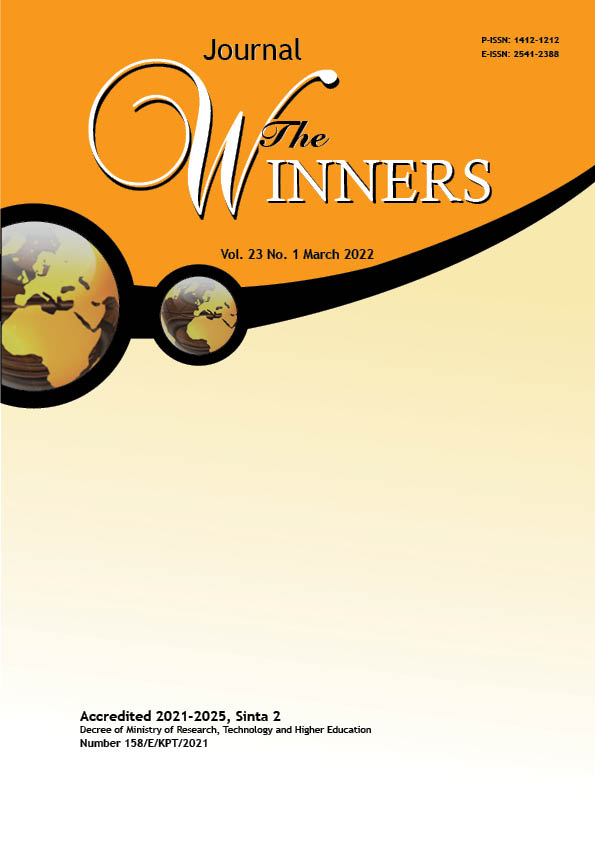The Effect of Opportunity Recognition and Organisation Capability on SME Performance in Indonesia Moderated by Business Model Innovation
DOI:
https://doi.org/10.21512/tw.v23i1.6932Keywords:
opportunity recognition, organisation capability, business model, small medium enterprisesAbstract
The research aimed to analyze the effect of opportunity recognition and organisation capability on SME's performance which is moderated by Business Model Innovation. It also aimed to find out and analyse the variables that most significantly affect SME's performance in Jakarta. Data collection were done by collectting questionnaires with 100 respondents who had business. In analysing data, the research used associative methods and moderated regression analysis. The results indicate that opportunity recognition and organisation capability have a significant effect on SME performance, and Business Model Innovation as moderator reduces the influence of opportunity recognition on SME performance but increase the influence of organisation capability on SME performance. Opportunity recognition and organisation capability have a relationship with SME performance, as evidenced by moderated regression analysis (β) of 1,589 and 0,479. After the Business Model Innovation moderates the two variables, the opportunity recognition relationship to SME performance has decreased to 0,657, and organisational capability to SME performance has increased to 0,724. Opportunity recognition, organisation capability, and Business Model Innovation also have a simultaneous influence on SME performance.
References
Anand, D. & Mantrala, M. (2019). Responding to disruptive business model innovations: the case of traditional banks facing fintech entrants. Journal of Banking and Financial Technology, 3(1), 19-31. https://doi.org/10.1007/s42786-018-00004-4
Bismo, A., Halim, W., & Erwinta, M. A. (2021). View of knowledge management strategy, innovation, and performance in Small Business Enterprise in Indonesia. The Winners, 22(1), 67-73. https://doi.org/10.21512/tw.v22i1.7045
Carayannis, E. G., Sindakis, S., & Walter, C. (2015). Business model innovation as lever of organizational sustainability. The Journal of Technology Transfer, 40(1), 85-104. https://doi.org/10.1007/s10961-013-9330-y
Chang, Y. Y. & Chen, M. H. (2020). Creative entrepreneurs’ creativity, opportunity recognition, and career success: Is resource availability a double-edged sword? European Management Journal, 38(5), 750-762. https://doi.org/10.1016/j.emj.2020.03.004
Chong, P. L., Ong, T. S., Abdullah, A., & Choo, W. C. (2019). Internationalisation and innovation on balanced scorecard (BSC) among Malaysian small and medium enterprises (SMEs). Management Science Letters, 9, 1617-1632. https://doi.org/10.5267/j.msl.2019.5.025
Gielnik, M. M., Frese, M., Graf, J. M., & Kampschulte, A. (2012). Creativity in the opportunity identification process and the moderating effect of diversity of information. Journal of Business Venturing, 27(5), 559-576. https://doi.org/10.1016/j.jbusvent.2011.10.003
Guo, H., Tang, J., Su, Z., & Katz, J. A. (2017). Opportunity recognition and SME performance: the mediating effect of business model innovation. R&D Management, 47(3), 431-442. https://doi.org/10.1111/radm.12219
Kasiri, L. A., Guan Cheng, K. T., Sambasivan, M., & Sidin, S. M. (2017). Integration of standardization and customization: Impact on service quality, customer satisfaction, and loyalty. Journal of Retailing and Consumer Services, 35, 91-97. https://doi.org/10.1016/j.jretconser.2016.11.007
Kokkonen, K. & Ojanen, V. (2018). From opportunities to action - An integrated model of small actors’ engagement in bioenergy business. Journal of Cleaner Production, 182, 496-508. https://doi.org/10.1016/j.jclepro.2018.02.013
Malagueño, R., Lopez-Valeiras, E., & Gomez-Conde, J. (2018). Balanced scorecard in SMEs: effects on innovation and financial performance. Small Business Economics, 51(1), 221-244. https://doi.org/10.1007/s11187-017-9921-3
Pucci, T., Nosi, C., & Zanni, L. (2017). Firm capabilities, business model design and performance of SMEs. Journal of Small Business and Enterprise Development, 24(2), 222-241. https://doi.org/10.1108/JSBED-09-2016-0138
Roundy, P. T., Harrison, D. A., Khavul, S., Pérez-Nordtvedt, L., & McGee, J. E. (2018). Entrepreneurial alertness as a pathway to strategic decisions and organizational performance. Strategic Organization, 16(2), 192-226. https://doi.org/10.1177/1476127017693970
Rua, O., França, A., & Ortiz, R. F. (2018). Key drivers of SMEs export performance: the mediating effect of competitive advantage. Journal of Knowledge Management, 22(2), 257-279. https://doi.org/10.1108/JKM-07-2017-0267
Sekaran, U. & Bougie, R. (2013). Research Methods for Business: A Skill Building Approach (6th Ed.). New York: Wiley & Sons. https://doi.org/10.1017/CBO9781107415324.004
Teece, D., Peteraf, M., & Leih, S. (2016). Dynamic capabilities and organizational agility: Risk, uncertainty, and strategy in the innovation economy. California Management Review, 58(4), 13-35. https://doi.org/10.1525/cmr.2016.58.4.13
Vogel, P. (2017). From venture idea to venture opportunity. Entrepreneurship Theory and Practice, 41(6), 943-971. https://doi.org/10.1111/etap.12234
Walter, A. T. (2020). Organizational agility: Ill-defined and somewhat confusing? A systematic literature review and conceptualization. Management Review Quarterly. https://doi.org/10.1007/s11301-020-00186-6
Downloads
Published
How to Cite
Issue
Section
License
Copyright (c) 2021 Hendry Hartono, Reeya Ardini

This work is licensed under a Creative Commons Attribution-ShareAlike 4.0 International License.
Authors who publish with this journal agree to the following terms:
a. Authors retain copyright and grant the journal right of first publication with the work simultaneously licensed under a Creative Commons Attribution License - Share Alike that allows others to share the work with an acknowledgment of the work's authorship and initial publication in this journal.
b. Authors are able to enter into separate, additional contractual arrangements for the non-exclusive distribution of the journal's published version of the work (e.g., post it to an institutional repository or publish it in a book), with an acknowledgment of its initial publication in this journal.
c. Authors are permitted and encouraged to post their work online (e.g., in institutional repositories or on their website) prior to and during the submission process, as it can lead to productive exchanges, as well as earlier and greater citation of published work.
USER RIGHTS
All articles published Open Access will be immediately and permanently free for everyone to read and download. We are continuously working with our author communities to select the best choice of license options, currently being defined for this journal as follows: Creative Commons Attribution-Share Alike (CC BY-SA)

















